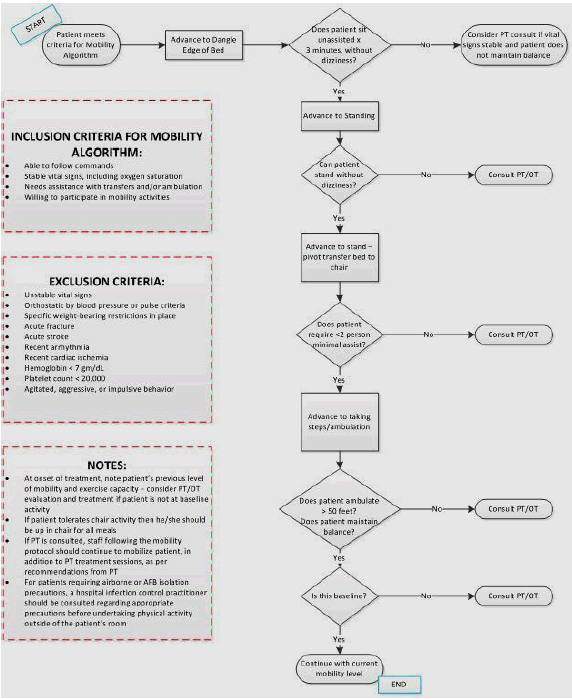Background: The purpose of this tool is to provide a sample algorithm for mobilization of patients. The mobility algorithm is meant for patients who have experienced deconditioning or are at risk for deconditioning. The algorithm is NOT intended for patients whose primary reason for admission is mobility related; such patients should be offered physical and occupational therapy, as appropriate.
Reference: Adapted from tools created by Central DuPage Hospital in Winfield, Illinois, and subsequently published in Drolet A. Dejuilio P, Harkless S, et al. Move to Improve: the feasibility of using an early mobility protocol to increase ambulation in the intensive and intermediate care settings. Phys Ther 2012 Sep 13. [Epub ahead of print]. Tool adapted with permission of the American Physical Therapy Association. This material is copyrighted, and any further reproduction or distribution requires written permission from APTA. This is not the final edited version that appeared in the journal article.
How to use this tool: Nursing assistants or other appropriate hospital staff can follow the mobility algorithm to initiate mobilization after the treating medical provider orders mobilization and the patient's nurse determines that the patient meets all inclusion criteria and does not have any exclusion criteria (see below).
This tool can be used in designing a new system, as a training tool for staff, and as an ongoing reference tool on hospital units. This tool can be modified or a new one created to meet the needs of your particular setting. If your hospital uses an electronic health record, consult your hospital's information systems staff about integrating this tool into the electronic health record.
Mobility Algorithm

[D] Text Description: The flowchart starts with "Patient meets criteria for mobility algorithm. Advance to Dangle Edge of Bed. Does patient sit unassisted x 3 minutes, without dizziness? If no, consider PT consult if vital signs stable and patient does not maintain balance. If yes, advance to standing. Can patient stand without dizziness? If no, consult PT/OT. If yes, advance to stand-pivot transfer bed to chair. Does patient require less than 2 person minimal assist? If no, consult PT/OT. If yes, advance to taking steps/ambulation. Does patient ambulate more than 50 feet? Does patient maintain balance? If no, consult PT/OT. If yes, is this baseline? If no, consult PT/OT. If yes, continue with current mobility level.
Inclusion criteria for mobility algorithm: Able to follow commands, stable vital signs, including oxygen saturation, needs assistance with transfers and/or ambulation, willing to participate in mobility activities.
Exclusion criteria: unstable vital signs, orthostatic by blood pressure or pulse criteria, specific weight-bearing restrictions in place, acute fracture, recent arrhythmia, recent cardiac ischemia, hemoglobin less than 7 gm/dL, platelet count below 20,000, agitated, aggressive, or impulsive behavior.
Notes: At onset of treatment, not patient's previous level of mobility and exercise capacity—consider PT/OT evaluation and treatment if patient is not at baseline activity. If patient tolerates chair activity then he/she should be up in chair for all meals. If PT is consulted, staff following mobility protocol should continue to mobilize patient, in addition to PT sessions, as per recommendations from PT. For patients requiring airborne or AFB isolation precautions, a hospital infection control practitioner should be consulted regarding appropriate precautions before undertaking physical activity outside of the patient's room.
Adapted from tools created by Central DuPage Hospital in Winfield, Illinois, and published in Drolet A, et al. Phys Ther 2012 Sep 13. [Epub ahead of print]. Tool adapted with permission of the American Physical Therapy Association. This material is copyrighted, and any further reproduction or distribution requires written permission from APTA. This is not the final edited version that appeared in the journal article.



